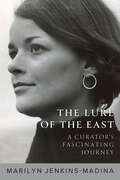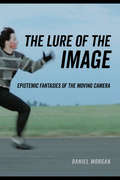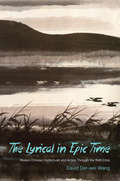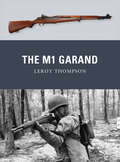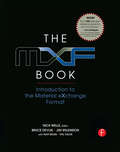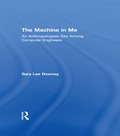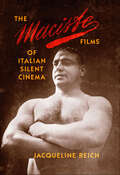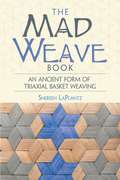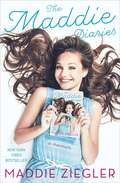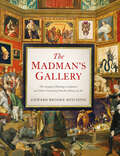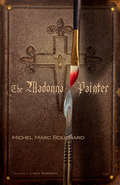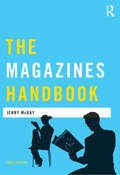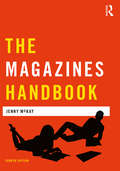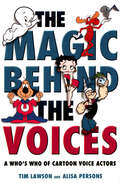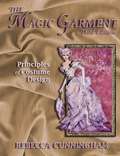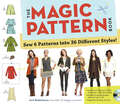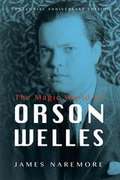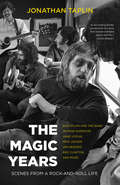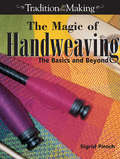- Table View
- List View
The Lure of the East: A Curator's Fascinating Journey
by Marilyn Jenkins-MadinaThe remarkable journey of one of the first women to become a curator of Islamic art at The Metropolitan Museum of Art and an internationally recognized scholar in the field. As a girl growing up in Frenchtown, New Jersey, Marilyn Jenkins-Madina recalls first learning about the Egyptian pyramids in sixth grade. That discovery opened her mind to the possibility of not only learning more about worlds far removed from her small-town existence, but of actually experiencing them and living them. Throughout her life, opportunities to follow uncharted roads have presented themselves in ways that she has not dismissed. It has been the driving force in her career and her life. She became a curator of Islamic art at The Metropolitan Museum of Art and an internationally recognized scholar in the field. She took more than 50 international trips, most of which were to the Middle East, at times and in locations where women were not exactly respected or welcomed in a capacity of authority. She came to enjoy an enduring friendship with Kuwaiti royalty. And, last but certainly not least, she became the wife and partner-in-adventure of a wonderful gentleman from Damascus who was a professor at Columbia University and also a Kurdish agha. From the banks of the Delaware to the shores of the Arabian Gulf and beyond, The Lure of the East: A Curator's Fascinating Journey is the story of her remarkable journey. Dr. Jenkins-Madina began her long curatorial career at The Metropolitan Museum of Art, New York in 1964. Having received her B.A. from Brown University in 1962, she continued to pursue her education while working at The Metropolitan Museum, earning both her M.A. and Ph.D. during this time. From her initial appointment as Curatorial Assistant, she rose through the ranks during her forty-year tenure as curator in the Department of Islamic Art and was named Curator Emerita upon her retirement in 2004. This memoir is meant to inspire others to dare to take their own road less traveled.
The Lure of the Image: Epistemic Fantasies of the Moving Camera
by Daniel MorganThe Lure of the Image shows how a close study of camera movement challenges key assumptions underlying a wide range of debates within cinema and media studies. Highlighting the shifting intersection of point of view and camera position, Daniel Morgan draws on a range of theoretical arguments and detailed analyses across cinemas to reimagine the relation between spectator and camera—and between camera and film world. With sustained accounts of how the camera moves in films by Fritz Lang, Guru Dutt, Max Ophuls, and Terrence Malick and in contemporary digital technologies, The Lure of the Image exposes the persistent fantasy that we move with the camera within the world of the film and examines the ways that filmmakers have exploited this fantasy. In so doing, Morgan provides a more flexible account of camera movement, one that enables a fuller understanding of the political and ethical stakes entailed by this key component of cinematic style.
The Lyrical in Epic Time
by David Der-Wei WangThis book positions the lyrical as key to rethinking the dynamics of Chinese modernity and emphasizes Chinese lyricism's deep roots in its own native traditions
The Lyrical in Epic Time: Modern Chinese Intellectuals and Artists Through the 1949 Crisis
by David Der-wei WangIn this book, David Der-wei Wang uses the lyrical to rethink the dynamics of Chinese modernity. Although the form may seem unusual for representing China's social and political crises in the mid-twentieth century, Wang contends that national cataclysm and mass movements intensified Chinese lyricism in extraordinary ways. Wang calls attention to the form's vigor and variety at an unlikely juncture in Chinese history and the precarious consequences it brought about: betrayal, self-abjuration, suicide, and silence. Despite their divergent backgrounds and commitments, the writers, artists, and intellectuals discussed in this book all took lyricism as a way to explore selfhood in relation to solidarity, the role of the artist in history, and the potential for poetry to illuminate crisis. They experimented with poetry, fiction, film, intellectual treatise, political manifesto, painting, calligraphy, and music. Western critics, Wang shows, also used lyricism to critique their perilous, epic time. He reads Martin Heidegger, Theodor Adorno, Cleanth Brooks, and Paul de Man, among others, to complete his portrait.The Chinese case only further intensifies the permeable nature of lyrical discourse, forcing us to reengage with the dominant role of revolution and enlightenment in shaping Chinese—and global—modernity. Wang's remarkable survey reestablishes Chinese lyricism's deep roots in its own native traditions, along with Western influences, and realizes the relevance of such a lyrical calling of the past century to our time.
The M1 Garand
by Peter Dennis Leroy ThompsonThe M1 Garand gave US infantrymen a marked edge during World War II. It shot faster and further than enemy infantry rifles and hit harder. No less an authority on killing the enemy than General George S. Patton called the Garand, "The greatest battle implement ever devised." At a time when opposing forces were armed with bolt action rifles, US troops had a highly reliable self-loader. It was the US Army's principal infantry weapon in World War II, beloved of troops for its ability to withstand hard use and be ready when needed. In most battles the Garands speed of fire combined with the powerful .30-06 cartridge gave US troops a distinct advantage. The eight-round clips which were used to load the M1 Garand were, however, viewed with mixed emotions by the troops on the ground. Eight rounds was not much magazine capacity for a self-loading rifle, thus requiring frequent reloading in combat. Some Army and Marine Corps troops allegedly felt that the distinctive "twang" as the Garand's clip was ejected when empty alerted the enemy that the soldiers were reloading and resulted in an attack. But this problem may have been overstated as experienced troops did not all empty their weapons at the same time. It was also a particularly heavy weapon in contrast to the much lighter M1 Carbine. But the Garand became the defining mankiller of the war, despite its weight and magazine problems, and many US combat veterans consider it one of the key reasons they survived the war, as one veteran succinctly commented, "I let my Garand do the talking."
The MXF Book: An Introduction to the Material eXchange Format
by Nick Wells Oliver Morgan Jim Wilkinson Bruce DevlinWritten by a top team of industry professionals, this must-have guide will introduce you to everything you'll need to know about MXF. The MXF Book introduces and explains the MXF standard and helps engineers write MXF applications. The book also explains the reasons behind many details of the specification documents.
The Machine in Me: An Anthropologist Sits Among Computer Engineers
by Gary Lee DowneyFirst Published in 1998. Routledge is an imprint of Taylor & Francis, an informa company.
The Maciste Films of Italian Silent Cinema
by Jacqueline ReichItalian film star Bartolomeo Pagano's "Maciste" played a key role in his nation's narratives of identity during World War I and after. Jacqueline Reich traces the racial, class, and national transformations undergone by this Italian strongman from African slave in Cabiria (1914), his first film, to bourgeois gentleman, to Alpine soldier of the Great War, to colonial officer in Italy's African adventures. Reich reveals Maciste as a figure who both reflected classical ideals of masculine beauty and virility (later taken up by Mussolini and used for political purposes) and embodied the model Italian citizen. The 12 films at the center of the book, recently restored and newly accessible to a wider public, together with relevant extra-cinematic materials, provide a rich resource for understanding the spread of discourses on masculinity, and national and racial identities during a turbulent period in Italian history. The volume includes an illustrated appendix documenting the restoration and preservation of these cinematic treasures.
The Mad Weave Book: An Ancient Form of Triaxial Basket Weaving
by Shereen LaplantzMost basket weaves are created on two axes but the triaxial method -- also known as mad weaving -- is formed on three axes for a strong and distinctive fabric that lends itself well to color patterns. Mad weaving has been practiced around the world for generations, from Asia to South America, but there are only a handful of instructional books on the subject. This detailed, easy-to-follow guide reintroduces the traditional craft to modern hand weavers with instructions for many different basket patterns. Author Shereen LaPlantz, an accomplished weaver and instructor, experimented for several years before developing a streamlined approach to making mad weave baskets. She begins with the basics, advancing to examples of color patterns, shaping, double weave, and surface embellishments, and she concludes with tips for finishing touches, from handles and lids to feet and reinforcements. Every step is accompanied by a clear diagram. Readers will delight in this guide's tremendous variety of patterns and find inspiration in its helpful suggestions and examples.
The Maddie Diaries: A Memoir
by Maddie ZieglerIn this New York Times bestselling memoir, the incredibly talented breakout star of Dance Moms and judge on So You Think You Can Dance brings her uplifting coming-of-age story about following her dreams and working hard to achieve success in both the dance world and in life.Maddie Ziegler knew one day she&’d be a star—she just didn&’t know how soon that day would come. At just eight years old, she was cast on Lifetime&’s hit reality show Dance Moms and quickly won the hearts of fans everywhere with her natural talent and determination. Soon, she was capturing attention from all over—including pop superstar Sia, who cast her as her dance double in the incredibly popular music video for her hit song &“Chandelier.&” The rest, as they say, was history. In this inspirational memoir, Maddie explains the hard work she put into her rise to stardom and how she keeps her balance along the way—starring in music videos, going on tour, and becoming an actress in The Book of Henry with Naomi Watts and Jacob Tremblay. She also answers her fans&’ burning questions with wise advice she&’s learned on her journey. With honesty, charm, and humor, Maddie offers her unique perspective on making her way in the entertainment world as a young teenager, reflecting on the lessons she&’s learned—and preparing for the exciting road ahead.
The Madman's Gallery: The Strangest Paintings, Sculptures and Other Curiosities from the History of Art
by Edward Brooke-HitchingBrought to light from the depths of libraries, museums, dealers, and galleries around the world, these forgotten artistic treasures include portraits of oddballs such as the British explorer with a penchant for riding crocodiles, and the Italian monk who levitated so often he's recognized as the patron saint of airplane passengers. Discover impossible medieval land yachts, floating churches, and eagle-powered airships. Encounter dog-headed holy men, armies of German giants, 18th-century stuntmen, human chessboards, screaming ghost heads, and more marvels of the human imagination. A captivating odditorium of obscure and engaging characters and works, each expertly brought to life by historian and curator of the strange Edward Brooke-Hitching, here is a richly illustrated and entertaining gallery for lovers of outré art and history.
The Madman's Library: The Strangest Books, Manuscripts and Other Literary Curiosities from History
by Edward Brooke-HitchingThis fascinating and bizarre collection compiles the most unusual, obscure books from the far reaches of the human imagination throughout history.From the author of the critically acclaimed bestsellers The Phantom Atlas and The Sky Atlas comes a unique and beautifully illustrated journey through the history of literature. The Madman's Library delves into its darkest territories to hunt down the oddest books and manuscripts ever written, uncovering the intriguing stories behind their creation.From the Qur'an written in the blood of Saddam Hussein, to the gorgeously decorated fifteenth-century lawsuit filed by the Devil against Jesus, to the most enormous book ever created, The Madman's Library features many long forgotten, eccentric, and extraordinary volumes gathered from around the world.Books written in blood and books that kill, books of the insane and books that hoaxed the globe, books invisible to the naked eye and books so long they could destroy the Universe, books worn into battle and books of code and cypher whose secrets remain undiscovered. Spell books, alchemist scrolls, wearable books, edible books, books to summon demons, books written by ghosts, and more all come together in the most curiously strange library imaginable.Featuring hundreds of remarkable images and packed with entertaining facts and stories to discover, The Madman’s Library is a captivating compendium perfect for bibliophiles, literature enthusiasts, and collectors intrigued by bizarre oddities, obscure history, and the macabre.• MUST-HAVE FOR BOOKLOVERS: Anyone who appreciates a good read will love delving into this weird world of books and adding this collection to their own bookshelf.• DISCOVER SOMETHING TRULY UNIQUE: The Madman's Library will let you in on the secret and obscure histories of the strangest books ever made.• EXPERT AUTHOR: Edward Brooke-Hitching is the son of an antiquarian book dealer, a lifelong rare book collector, and a master of taking visual deep dives into unusual historical subjects, such as the maps of imaginary geography in The Phantom Atlas or ancient pathways through the stars in The Sky Atlas.
The Madonna Painter
by Linda Gaboriau Michel Marc BouchardAt the end of the Great War, to protect his village from the Spanish flu epidemic, a priest commissions an Italian painter to decorate the local church with a fresco dedicated to the Virgin Mary. The painter is to choose, among four local women all named Mary, a model for his work. Superstition collides with desire, and lies are unmasked.
The Magazines Handbook
by Jenny McKayThe Magazines Handbook has firmly established itself as the essential introduction to the theories and practices of the modern magazine industry. This fully updated third edition comprehensively examines the business of publishing magazines today and the work of the contemporary magazine journalist. Jenny McKay draws examples from a broad range of publications to explore key jobs in the industry, covering everyone from the sub editor to the fashion assistant, as well as analysing the many skills involved in magazine journalism, including commissioning, researching, interviewing, and production. Updated specialist chapters discuss the growth and development of electronic publishing and online journalism, new directions in magazine design, photography and picture editing, and the most up to date legal frameworks in which magazine journalists must operate. The Magazines Handbook includes: • Interviews with magazine journalists, editors, and publishers • Advice on starting out and freelancing in the magazine industry • An analysis of ‘new journalism’ and reportage • A glossary of key terms and specialist concepts • Information on contacts, courses and professional training.
The Magazines Handbook (Media Practice)
by Jenny McKayThe Magazines Handbook is an introductory guide to all aspects of magazine journalism and publishing. The book explores the latest innovations in digital design and delivery, whilst also reaffirming the continued importance of key journalistic skills, including good interviewing, feature writing and news writing. The book includes chapters on the visual aspects of magazines, such as illustration and picture editing, and chapters covering the business background of this increasingly global industry. Jenny McKay offers tips on training and work experience as well as outlining the function of various editorial jobs. Profiles of four young journalists give a flavour of life in the early years of a career. Chapters include: advice on embarking on a career in magazine journalism; an overview of magazine design and the production process; analysis of the state of the magazine industry today, with a look to its future; a discussion of legal issues related to magazine journalism; a glossary of key terms and recommended reading in every chapter. Now in its fourth edition, The Magazines Handbook offers a nuanced and reflective account of periodical journalism, ideal for students of journalism and budding professionals who are seeking a useful starting point for wide-ranging academic discussion about magazines.
The Magic Behind the Voices: A Who's Who of Cartoon Voice Actors
by Tim Lawson Alisa PersonsThe Magic Behind the Voices is a fascinating package of biographies, anecdotes, credit listings, and photographs of the actors who have created the unmistakable voices for some of the most popular and enduring animated characters of all time. Drawn from dozens of personal interviews, the book features a unique look at thirty-nine of the hidden artists of show business. Often as amusing as the characters they portray, voice actors are charming, resilient people—many from humble beginnings—who have led colorful lives in pursuit of success. Beavis and Butthead and King of the Hill's Mike Judge was an engineer for a weapons contractor turned self-taught animator and voice actor. Nancy Cartwright (the voice of Bart Simpson) was a small-town Ohio girl who became the star protégé of Daws Butler—most famous for Yogi Bear, Huckleberry Hound, and Quick Draw McGraw. Mickey Mouse (Wayne Allwine) and Minnie Mouse (Russi Taylor) were a real-life husband-and-wife team. Spanning many studios and production companies, this book captures the spirit of fun that bubbles from those who create the voices of favorite animated characters. In the earliest days of cartoons, voice actors were seldom credited for their work. A little more than a decade ago, even the Screen Actors Guild did not consider voice actors to be real actors, and the only voice actor known to the general public was Mel Blanc. Now, Oscar-winning celebrities clamor to guest star on animated television shows and features. Despite the crushing turnouts at signings for shows such as Animaniacs, The Simpsons, and SpongeBob Squarepants, most voice actors continue to work in relative anonymity. The Magic Behind the Voices features personal interviews and concise biographical details, parting the curtain to reveal creators of many of the most beloved cartoon voices.
The Magic Garment: Principles of Costume Design
by Rebecca CunninghamSuccessful costume design requires a solid foundation in general artistic principles and specific knowledge of how to apply those principles. The author presents readers with just such a foundation and develops it to expose beginning costume designers to the myriad skills they need to develop in order to costume successful stage productions. She begins at the most basic conceptual level reading plays from a costume designer's perspective. She then follows through with the practical considerations that must be considered at every stage of the costuming process research, development, sketching, and costume construction. The author has built on the long-standing success of the outstanding first edition with new figures and updates throughout the text, including 24 pages in full color. Examples have been selected from a wide range of stage productions representing a variety of designers, styles, and approaches. Interviews with award-winning designers from stage, film, and other media show the practical importance of the book's concepts. Every chapter incorporates material reflecting the ever-increasing impact of technology, especially computers, on costuming. New to this edition is an ancillary download package, giving students a selection of basic figure drawings to serve as the base layer for digital renderings, ready-made forms and checklists for assembling and organizing costumes for shows, and a list of research and reference websites with easily clickable links.
The Magic Lantern: An Autobiography
by Ingmar BergmanThe Magic Lantern: An Autobiography by Ingmar Bergman. Bearing all the narrative trademarks of a Bergman film, his autobiography unfolds not in strict chronology, but as a series of flashbacks to his childhood of bitter unhappiness: "our family", he writes "were men and women with a catastrophic heritage of excessive demands, bad conscience, and guilt". Translated by Joan Tate.
The Magic Loop
by Bev GaleskasThis book explains a simple way to knit seamless socks, sleeves, neckbands, baby sweaters, mittens, and gloves using one long circular needle instead of double pointed needles. 3 projects: Ruffled Wristlets, Winter Socks, and Toe-up Baby Socks. 20 pages.
The Magic Paintbrush
by Ellen L. RamseyLiang is given a magical paintbrush that has the power to turn anything he paints into real life.
The Magic Pattern Book: Sew 6 Patterns into 36 Different Styles!
by Amy BarickmanHome sewing is booming again. Inspired by sites like Etsy, Craftsy, Pinterest, and CreativeBug, by the continuing popularity of Project Runway and other fashion shows, and by the ever-growing DIY movement, there are more than 35 million sewists in America. Now, for this new generation that wants to make their own clothes, express their fashion sense, look great, be creative—and save money, to boot—comes Amy Barickman’s The Magic Pattern Book, an illustrated guide to creating a one-of-a-kind wardrobe from six magic patterns. What makes a sewing pattern magic? It’s a simple equation: One “magic” pattern can be transformed into six different looks—for example, The Skirt (pattern B) yields an A-line skirt, a maxi skirt, a pleated hem skirt, a pencil wrap skirt, a flared bias skirt, and a ruffled mini. Then comes even more magic—there are six magic patterns in The Magic Pattern Book, resulting in thirty-six different looks. Following each look are suggestions for specific fabrics, many of them repurposed items, for a total of 216 garments and accessories. The skill level is basic, and patterns are bundled onto a CD in an envelope in the back of the book, and also found online (to be downloaded and printed out on 81/2" x 11" paper). What makes a book magic? Another simple equation: great value, a great promise, a great package, and a great author.
The Magic World of Orson Welles
by James NaremoreProdigy. Iconoclast. Genius. Exile. Orson Welles remains one of the most discussed figures in cinematic history. In the centenary year of Welles's birth, James Naremore presents a revised third edition of this incomparable study, including a new section on the unfinished film The Other Side of the Wind . Naremore analyzes the political and psychological implications of the films, Welles's idiosyncratic style, and the biographical details--both playful and vexing--that impacted each work. Itself a historic film study, The Magic World of Orson Welles unlocks the soaring art and quixotic methods of a master.
The Magic Years: Scenes from a Rock-and-Roll Life
by Jonathan TaplinJonathan Taplin’s extraordinary journey has put him at the crest of every major cultural wave in the past half century: he was tour manager for Bob Dylan and The Band in the 60s, producer of major films in the 70s, an executive at Merrill Lynch in the 80s, creator of the Internet’s first Video-on-Demand service in the 90s, and a cultural critic and author writing about technology in the new millennium. His is a lifetime marked not only by good timing but by impeccable instincts—from the folk scene of Woodstock, to Hollywood’s rebellious film movement and beyond, Taplin is not just a witness but a lifelong producer, the right-hand man to some of the greatest talents of both pop culture and the underground. With cameos by Janis Joplin, Jimi Hendrix, Eric Clapton, Martin Scorsese, and countless other icons, The Magic Years is both a rock memoir and a work of cultural criticism from a key player who watched a nation turn from idealism to nihilism. Taplin offers a clear-eyed roadmap of how we got here and makes a convincing case for art’s power to deliver us from &“passionless detachment&” and rekindle our humanism.
The Magic of Handweaving: The Basics and Beyond
by Sigrid PirochExperience the Magic of Handweaving Sigrid Piroch is an experienced weaver who leads readers on a journey through the world of cloth. She will guide you through the beginning stages of weaving, from planning and designing, to the final stages, when the beautiful piece of cloth is ready to take off the loom. You will also learn about weavers around the world who weave cloth out of necessity, tradition, and art. This is a resource for all those with an interest in the amazing process. The book includes: A glossary of tools and terms A guide to choosing your own loom Step-by-step projects with easy-to-follow illustrations Design instructions and ideas Inspirational photos
The Magic of MinaLima: Celebrating the Graphic Design Studio Behind the Harry Potter & Fantastic Beasts Films
by Nell DentonA full-color illustrated compendium chronicling the magical twenty-year journey of acclaimed art and design studio, MinaLima, the creative genius behind the graphics for the Harry Potter film series.“It all started with a letter . . .” Miraphora Mina and Eduardo Lima began their extraordinary partnership in 2001 when Warner Bros. invited them to realize the imaginative visual universe of the Harry Potter film series. The two artists would never have guessed that the graphic props they designed for the films—including the Hogwarts acceptance letter, Marauder’s Map, Daily Prophet newspaper, The Quibbler and Weasleys’ Wizard Wheezes—would become cultural icons loved by Wizarding World fans around the world. Eight years later, the pair formed their own design studio, MinaLima, and expanded their work to include the graphics for the Wizarding World of Harry Potter—Diagon Alley and Hogsmeade at Universal Orlando Resort and the Fantastic Beasts film series. To showcase their treasury of designs, the studio has opened House of MinaLima, its immersive art galleries and shops in London and across the world.The Magic of MinaLima is an illustrated history and celebration of Mina and Lima’s twenty-year evolution and groundbreaking vision. Their wondrous creations illuminate the Wizarding World as never before, and their commentary offers insights into the imaginative thinking that shaped their designs. This collection showcases the very best works from the award-winning studio’s two decades and includes interactive elements such as the Marauder’s Map, the Black Family Tapestry, and Weasleys’ Wizard Wheezes.Designed to delight and enchant, The Magic of MinaLima will be an invaluable resource for Wizarding World and graphic art fans alike.
